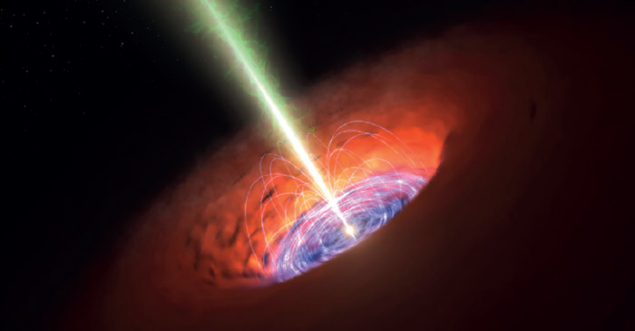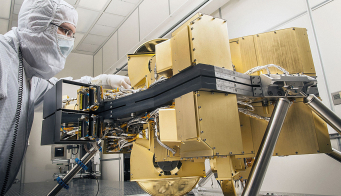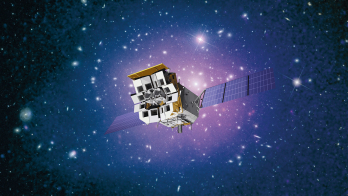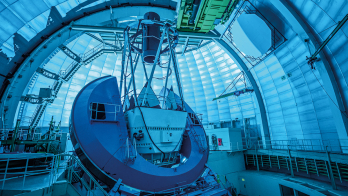
Image credit: ESO/L Calçada.
The Atacama Large Millimetre/submillimetre Array (ALMA) has revealed an intense magnetic field at the base of the relativistic jet powered by a supermassive black hole. Probing the physical conditions of a jet so close to the black hole is unprecedented, and confirms that magnetic fields have a driving role in the formation and collimation of the jet.
Supermassive black holes, often with masses billions of times that of the Sun, are located at the heart of almost all galaxies in the universe. These black holes can accrete huge amounts of matter from a surrounding disc. While most of this matter is fed into the black hole, some can escape moments before capture and be flung out into space at close to the speed of light in twin plasma jets, which can extend hundreds of thousands of light-years from their host galaxy (Picture of the month, CERN Courier January/February 2013 p14). How this happens is not well understood, although it is thought that strong magnetic fields, acting very close to the event horizon, play a crucial role in this process.
Up to now, only weak magnetic fields far from black holes – several light-years away – have been probed. A new study by astronomers from Chalmers University of Technology and Onsala Space Observatory in Sweden used ALMA to detect a polarization signal related to the strong magnetic field in a distant galaxy named PKS 1830-211. This quasar was chosen because it is located at a relatively high redshift and is gravitationally lensed. The redshift of z = 2.5 allows submillimetre emission from the distant source to be probed at frequencies 3.5 times higher than reachable by ALMA. An observation at 300 GHz (around 1 mm) therefore probes the terahertz frequency range (around 0.3 mm), where synchrotron self-absorption no longer hides the most intense jet region closest to the black hole.
The gravitational lens splits the remote source into two components, so that Ivan Martí-Vidal and colleagues could study the relative polarization of the two lensed images. This strategy allows them to be free of many calibration-related artefacts that would otherwise limit the analysis. Through repeated observations at different wavelengths, they found clear signals of Faraday rotation that are hundreds of times stronger than previously found in the universe. The strength of this wavelength dependence of the rotation of the polarization angle is given by the rotation measure (RM), which depends on the magnetic field strength multiplied by the electron density integrated along the line of sight.
The RM derived with ALMA in PKS 1830-211 is around 108 rad/m2, which is about 100,000 times greater than in the radio cores of other quasars. This huge difference is owing to the new observations being performed at much higher frequencies, thus probing a region only light-days away from the black hole, instead of light-years when observing in the radio domain. Assuming that both the magnetic field and the electron density increase by about a factor of 300 from the radio core to the apex of the jet, the team obtains a magnetic field of at least a few tens of gauss near the base of the jet. While this is only an order-of-magnitude estimate, its relatively high value – although many billions of times weaker than in neutron stars – reinforces the idea that magnetic fields play an important role in the mechanism that launches the jet.







